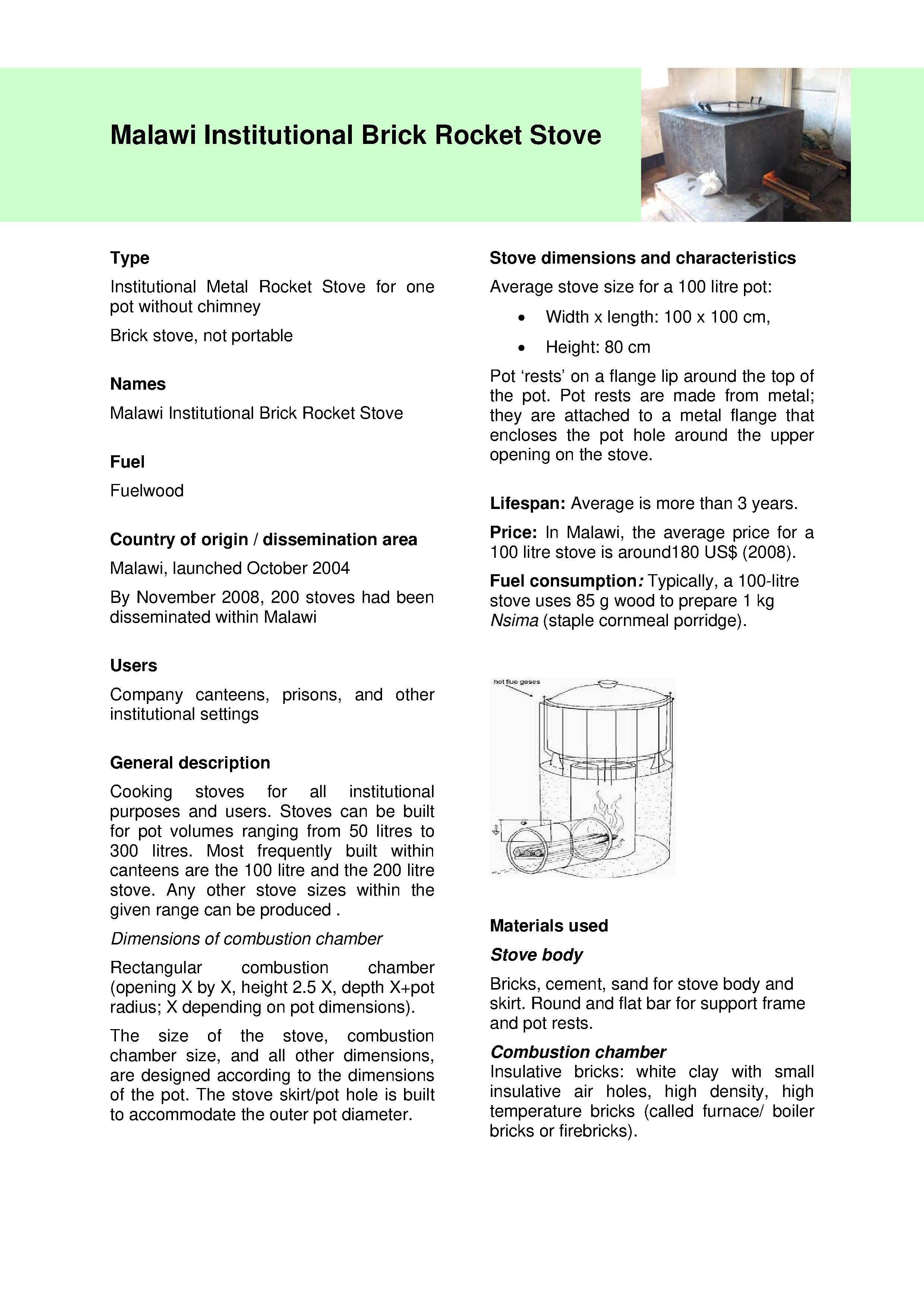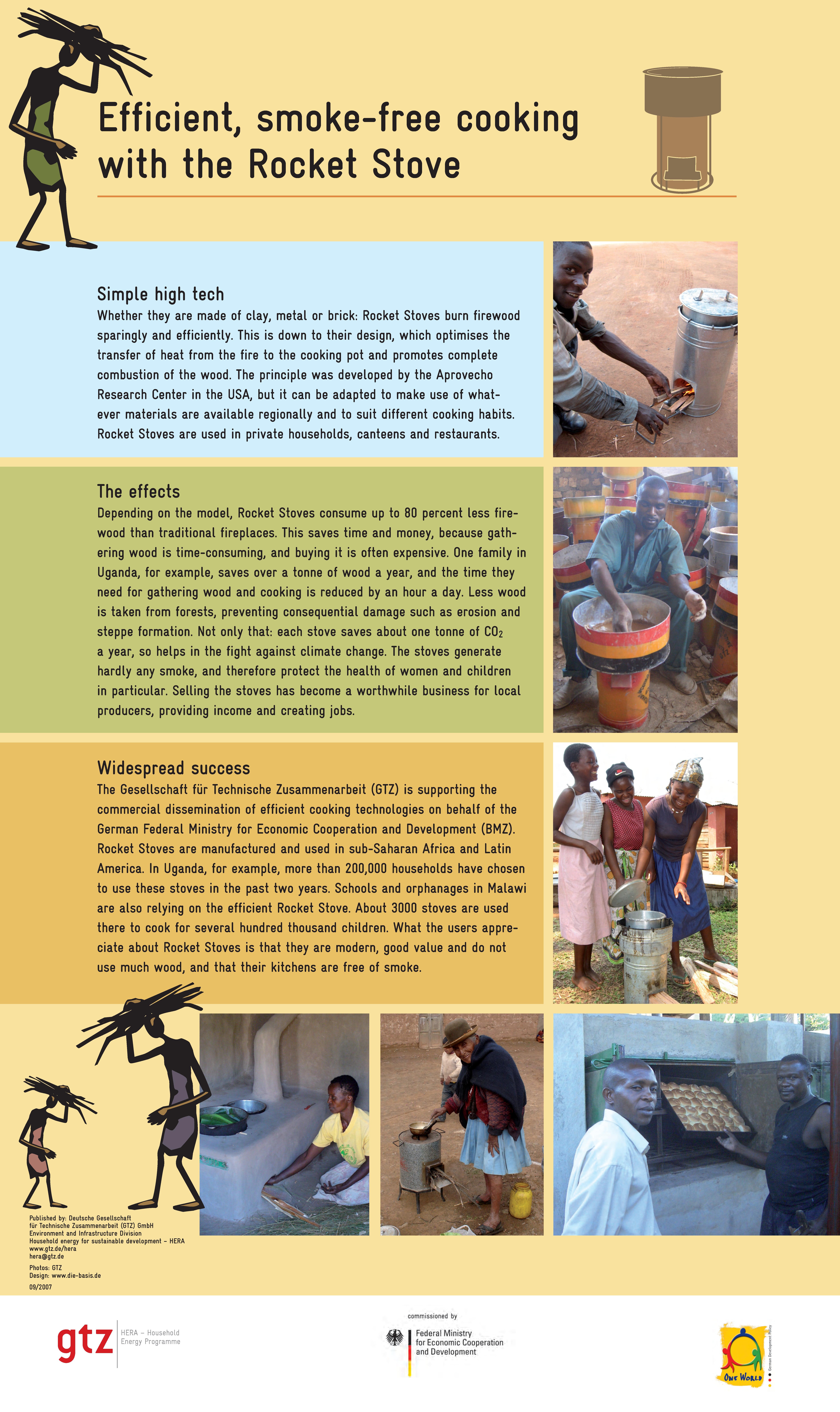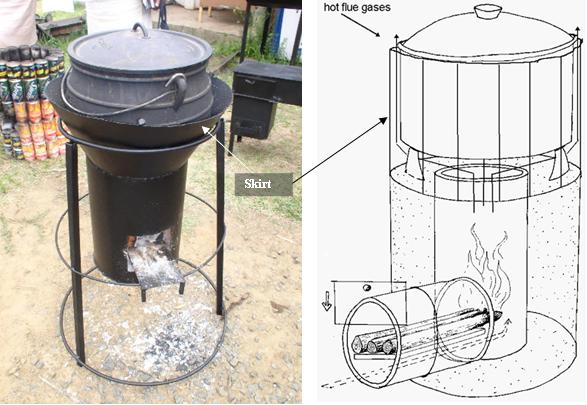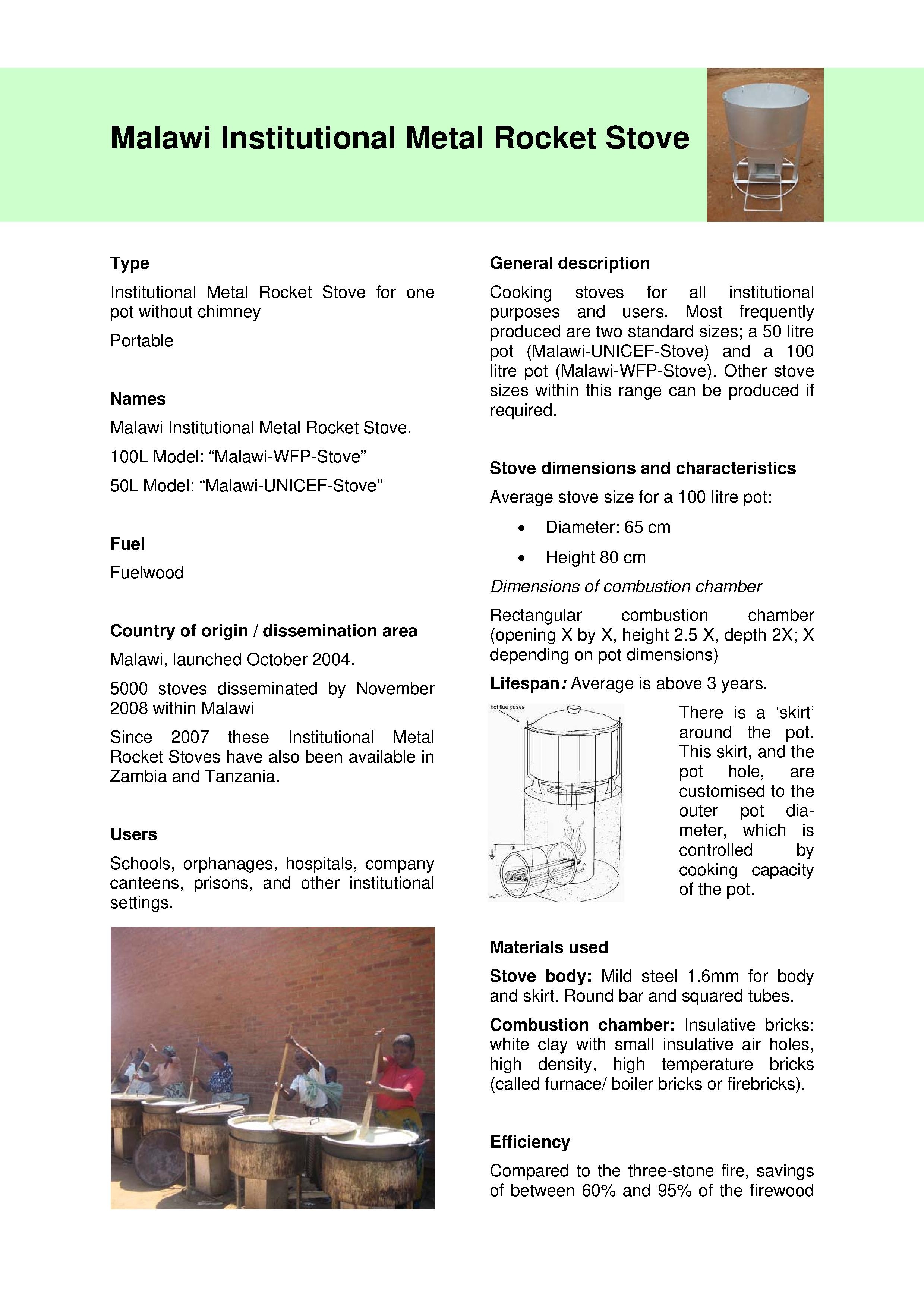Knowledge fuels change
For over a decade, Energypedia has shared free, reliable energy expertise with the world.
We’re now facing a serious funding gap.
Help keep this platform alive — your donation, big or small, truly matters!
Thank you for your support
Difference between revisions of "Firewood Cookstoves"
***** (***** | *****) |
***** (***** | *****) |
||
| Line 1: | Line 1: | ||
| − | [[ | + | [[GIZ_HERA_Cooking_Energy_Compendium|--> Back to Overview GIZ HERA Cooking Energy Compendium]] |
| − | = Types of woodfuel stoves | + | = Types of woodfuel stoves = |
| − | == Wood stoves<br> | + | == Wood stoves<br/> == |
| − | Improved woodstoves are found in many shapes and sizes. However, to achieve overall efficiency, there are two key technical principles that are always the same: | + | Improved woodstoves are found in many shapes and sizes. However, to achieve overall efficiency, there are two key technical principles that are always the same: |
| − | *improved combustion (getting the fuel/air mix correct and the temperature high quickly) | + | *improved combustion (getting the fuel/air mix correct and the temperature high quickly) |
*improved heat transfer to the pot (loosing as little as possible of the heat to the surrounding air) | *improved heat transfer to the pot (loosing as little as possible of the heat to the surrounding air) | ||
| − | The best stoves optimize both heat transfer and combustion efficiency at the same time. Increased heat transfer reduces fuel requirements, whereas increased combustion efficiency reduces fuel requirements and decreases harmful emissions. The organisation Aprovecho (a NGO in the US), provides a detailed description of how to achieve this two principles in their book; Design Principles for Wood Burning Cook Stoves (http://www.aprovecho.org ). | + | The best stoves optimize both heat transfer and combustion efficiency at the same time. Increased heat transfer reduces fuel requirements, whereas increased combustion efficiency reduces fuel requirements and decreases harmful emissions. The organisation Aprovecho (a NGO in the US), provides a detailed description of how to achieve this two principles in their book; Design Principles for Wood Burning Cook Stoves ([http://www.aprovecho.org http://www.aprovecho.org] ). |
| − | == The Rocket Stove Principle<br> | + | == The Rocket Stove Principle<br/> == |
| − | ''One of the most successful new concepts in stove design is the '''rocket stove principle'''. | + | ''One of the most successful new concepts in stove design is the '''rocket stove principle'''.'' |
| − | *It has a '''tall combustion chamber '''which behaves a bit like a chimney; creating more draught than a standard stove. This assists in mixing the air, fuel particles and volatiles, resulting in a hot flame. The '''internal walls are insulated''', reflecting all the heat back into the chamber rather than losing it to the stove body. The insulation keeps everything very hot so that the chemical reaction is more intense, whilst the tall chamber provides more time in which the gases and particles can be burnt completely, giving out all their heat and discharging mainly carbon dioxide and water vapour. | + | *It has a '''tall combustion chamber '''which behaves a bit like a chimney; creating more draught than a standard stove. This assists in mixing the air, fuel particles and volatiles, resulting in a hot flame. The '''internal walls are insulated''', reflecting all the heat back into the chamber rather than losing it to the stove body. The insulation keeps everything very hot so that the chemical reaction is more intense, whilst the tall chamber provides more time in which the gases and particles can be burnt completely, giving out all their heat and discharging mainly carbon dioxide and water vapour. |
| − | *These hot flue gases pass through a '''well defined gap''' between a ‘skirt’, and the pot, as shown in the illustrations given below, resulting in a large percentage of the heat being forced against the sides of the pot, and being transferred to the pot. Where various sizes of pot are used on the same stove, the skirt can be funnel-shaped to accommodate different pots, although some efficiency will be lost. | + | *These hot flue gases pass through a '''well defined gap''' between a ‘skirt’, and the pot, as shown in the illustrations given below, resulting in a large percentage of the heat being forced against the sides of the pot, and being transferred to the pot. Where various sizes of pot are used on the same stove, the skirt can be funnel-shaped to accommodate different pots, although some efficiency will be lost. |
*An elbow-shaped '''combustion chamber''', with a shelf for the fuel wood, supports the pre-drying of the firewood and allows a controlled, and sufficient, flow of primary air to be warmed as it passes under the wood to the burning wood tips. | *An elbow-shaped '''combustion chamber''', with a shelf for the fuel wood, supports the pre-drying of the firewood and allows a controlled, and sufficient, flow of primary air to be warmed as it passes under the wood to the burning wood tips. | ||
| − | |||
| − | |||
| − | + | [[File:RocketStove.jpg]] | |
| − | + | The rocket stove principle. Source: Aprovecho | |
| − | |||
| − | |||
| − | |||
| − | |||
| − | |||
| − | + | Design principles, which can be used more generally include: | |
| − | A | + | *Insulation around the fire and along the entire heat flow path using lightweight, heat resistant materials |
| + | *A well-controlled, uniform draught in the burning chamber during the entire combustion process | ||
| + | *Use of a grate or a shelf under the firewood | ||
| + | *Heat transfer maximised by the insertion of the pot into the stove body or using a skirt around the pot. | ||
| − | + | [[File:Pic2.JPG]] | |
| − | {| | + | A rocket-type stove in action, and showing insulation of the burning chamber, skirt around pot and support frame. Source: GIZ / Aprovecho Institute |
| + | |||
| + | <br/>Today most of the GIZ-promoted high-efficiency wood stoves follow this rocket stove principle (see fact sheets for the examples): | ||
| + | |||
| + | {| style="" border="1" cellpadding="1" cellspacing="1" width="100%" | ||
|- | |- | ||
| − | | [[ | + | | [[File:Final rocket lorena uganda stove factsheet 2008.pdf]] |
| Two pot rocket Lorena, '''Uganda '''(2008) | | Two pot rocket Lorena, '''Uganda '''(2008) | ||
|- | |- | ||
| − | | [[ | + | | [[File:One pot mud rocket stove factsheet 2008.pdf|Draft shielded fire stove fact sheet.pdf]] |
| One-Pot Rocket Mud Stove, Shielded Fire, '''Uganda''' (2008) | | One-Pot Rocket Mud Stove, Shielded Fire, '''Uganda''' (2008) | ||
|- | |- | ||
| − | | [[ | + | | [[File:En-GTZ-Uganda Rocket Institutional-2006.pdf]]<br/> |
| − | | Rocket Institutional Stove, '''Uganda''' (2006)<br> | + | | Rocket Institutional Stove, '''Uganda''' (2006)<br/> |
|- | |- | ||
| | | | ||
| − | [[ | + | [[File:Final-inst metal rocket stove malawi-2008.pdf]] |
| − | | Institutional Metal Rocket Stove, <span style="font-weight: bold | + | | Institutional Metal Rocket Stove, <span style="font-weight: bold">Malawi</span> (2008)<br/> |
|- | |- | ||
| − | | [[ | + | | [[File:Final inst brick rocket stove malawi 2008.pdf|Final-inst metal rocket stove malawi-2008.pdf]] |
| Malawi Institutional Brick Rocket Stove, '''Malawi '''(2008) | | Malawi Institutional Brick Rocket Stove, '''Malawi '''(2008) | ||
|- | |- | ||
| − | | [[ | + | | [[File:Inkawasi stove peru factsheet 2008.pdf|Draft inkawasina-stove peru-k2-e2-lisa1.pdf]]<br/> |
| The Inkawasi Stove, '''Peru ''' (2008) | | The Inkawasi Stove, '''Peru ''' (2008) | ||
|} | |} | ||
| − | |||
| − | |||
| − | <br> | + | Efficient, smoke-free cooking with the Rocket Stove:<br/>[[File:En-Poster Rocket Stove-2007.pdf]] |
| + | |||
| + | |||
| − | == New wood fuel stove designs<br> | + | == New wood fuel stove designs<br/> == |
| − | Two major factors determine if woodfuels burn clean and efficient: its dryness and sufficient ventilation, hence, the right amount of air on the right spot during the process to ensure a complete combustion. | + | Two major factors determine if woodfuels burn clean and efficient: its dryness and sufficient ventilation, hence, the right amount of air on the right spot during the process to ensure a complete combustion. |
| − | While it depends on the user to make sure that the fuel is dry, the air-flow depends on the stove design. In a natural draught stove, the movement of air is created by the chimney or stack height of the fuel. However, there must be a difference in temperature between the stove and the top of the chimney for generating draught. Natural draught is likely to cause incomplete combustion with higher emissions and energy losses through the chimney. Moreover, it is also difficult to regulate. | + | While it depends on the user to make sure that the fuel is dry, the air-flow depends on the stove design. In a natural draught stove, the movement of air is created by the chimney or stack height of the fuel. However, there must be a difference in temperature between the stove and the top of the chimney for generating draught. Natural draught is likely to cause incomplete combustion with higher emissions and energy losses through the chimney. Moreover, it is also difficult to regulate. |
| − | == Wood fuel stoves with forced convection<br> | + | == Wood fuel stoves with forced convection<br/> == |
| − | Instead of naturally ‘pulling’ air through a stove by stack height, fans or blowers are useful to ‘push’ air into the combustion chamber. This enhances a good air-fuel mix and thus, more complete combustion. Electricity is the most convenient power source to create a forced air-flow. It can be provided by batteries or, if available, through the grid. Recently thermo-electric generators (TEG) are being developed to power fans in stoves. They use the temperature differences within the stove to generate electricity. Though TEGs have great potential to provide also power to other applications (LEDs, cell phone charging), they are still in their infancy. Forced convection can reduce emissions of stoves by up to 90 % and thus alleviating IAP levels. More test results from more widespread use are expected soon. | + | Instead of naturally ‘pulling’ air through a stove by stack height, fans or blowers are useful to ‘push’ air into the combustion chamber. This enhances a good air-fuel mix and thus, more complete combustion. Electricity is the most convenient power source to create a forced air-flow. It can be provided by batteries or, if available, through the grid. Recently thermo-electric generators (TEG) are being developed to power fans in stoves. They use the temperature differences within the stove to generate electricity. Though TEGs have great potential to provide also power to other applications (LEDs, cell phone charging), they are still in their infancy. Forced convection can reduce emissions of stoves by up to 90 % and thus alleviating IAP levels. More test results from more widespread use are expected soon. |
| − | '''Additional information '''<br>BioLite: [http://www.biolitestove.com/Technology.html http://www.biolitestove.com/Technology.html] | + | '''Additional information '''<br/>BioLite: [http://www.biolitestove.com/Technology.html http://www.biolitestove.com/Technology.html] |
| − | <br> [[Cooking with firewood#Types_of_woodfuel_stoves|Top of the page]] | + | <br/>[[Cooking with firewood#Types_of_woodfuel_stoves|Top of the page]] |
| − | [[ | + | [[GIZ_HERA_Cooking_Energy_Compendium|--> Back to Overview GIZ HERA Cooking Energy Compendium]] |
| − | + | [[Category:GIZ_HERA]] | |
Revision as of 15:15, 29 August 2011
--> Back to Overview GIZ HERA Cooking Energy Compendium
Types of woodfuel stoves
Wood stoves
Improved woodstoves are found in many shapes and sizes. However, to achieve overall efficiency, there are two key technical principles that are always the same:
- improved combustion (getting the fuel/air mix correct and the temperature high quickly)
- improved heat transfer to the pot (loosing as little as possible of the heat to the surrounding air)
The best stoves optimize both heat transfer and combustion efficiency at the same time. Increased heat transfer reduces fuel requirements, whereas increased combustion efficiency reduces fuel requirements and decreases harmful emissions. The organisation Aprovecho (a NGO in the US), provides a detailed description of how to achieve this two principles in their book; Design Principles for Wood Burning Cook Stoves (http://www.aprovecho.org ).
The Rocket Stove Principle
One of the most successful new concepts in stove design is the rocket stove principle.
- It has a tall combustion chamber which behaves a bit like a chimney; creating more draught than a standard stove. This assists in mixing the air, fuel particles and volatiles, resulting in a hot flame. The internal walls are insulated, reflecting all the heat back into the chamber rather than losing it to the stove body. The insulation keeps everything very hot so that the chemical reaction is more intense, whilst the tall chamber provides more time in which the gases and particles can be burnt completely, giving out all their heat and discharging mainly carbon dioxide and water vapour.
- These hot flue gases pass through a well defined gap between a ‘skirt’, and the pot, as shown in the illustrations given below, resulting in a large percentage of the heat being forced against the sides of the pot, and being transferred to the pot. Where various sizes of pot are used on the same stove, the skirt can be funnel-shaped to accommodate different pots, although some efficiency will be lost.
- An elbow-shaped combustion chamber, with a shelf for the fuel wood, supports the pre-drying of the firewood and allows a controlled, and sufficient, flow of primary air to be warmed as it passes under the wood to the burning wood tips.
The rocket stove principle. Source: Aprovecho
Design principles, which can be used more generally include:
- Insulation around the fire and along the entire heat flow path using lightweight, heat resistant materials
- A well-controlled, uniform draught in the burning chamber during the entire combustion process
- Use of a grate or a shelf under the firewood
- Heat transfer maximised by the insertion of the pot into the stove body or using a skirt around the pot.
A rocket-type stove in action, and showing insulation of the burning chamber, skirt around pot and support frame. Source: GIZ / Aprovecho Institute
Today most of the GIZ-promoted high-efficiency wood stoves follow this rocket stove principle (see fact sheets for the examples):

|
Two pot rocket Lorena, Uganda (2008) |
| Draft shielded fire stove fact sheet.pdf | One-Pot Rocket Mud Stove, Shielded Fire, Uganda (2008) |
| File:En-GTZ-Uganda Rocket Institutional-2006.pdf |
Rocket Institutional Stove, Uganda (2006) |
| Institutional Metal Rocket Stove, Malawi (2008) | |

|
Malawi Institutional Brick Rocket Stove, Malawi (2008) |
| Draft inkawasina-stove peru-k2-e2-lisa1.pdf |
The Inkawasi Stove, Peru (2008) |
Efficient, smoke-free cooking with the Rocket Stove:
New wood fuel stove designs
Two major factors determine if woodfuels burn clean and efficient: its dryness and sufficient ventilation, hence, the right amount of air on the right spot during the process to ensure a complete combustion.
While it depends on the user to make sure that the fuel is dry, the air-flow depends on the stove design. In a natural draught stove, the movement of air is created by the chimney or stack height of the fuel. However, there must be a difference in temperature between the stove and the top of the chimney for generating draught. Natural draught is likely to cause incomplete combustion with higher emissions and energy losses through the chimney. Moreover, it is also difficult to regulate.
Wood fuel stoves with forced convection
Instead of naturally ‘pulling’ air through a stove by stack height, fans or blowers are useful to ‘push’ air into the combustion chamber. This enhances a good air-fuel mix and thus, more complete combustion. Electricity is the most convenient power source to create a forced air-flow. It can be provided by batteries or, if available, through the grid. Recently thermo-electric generators (TEG) are being developed to power fans in stoves. They use the temperature differences within the stove to generate electricity. Though TEGs have great potential to provide also power to other applications (LEDs, cell phone charging), they are still in their infancy. Forced convection can reduce emissions of stoves by up to 90 % and thus alleviating IAP levels. More test results from more widespread use are expected soon.
Additional information
BioLite: http://www.biolitestove.com/Technology.html





















